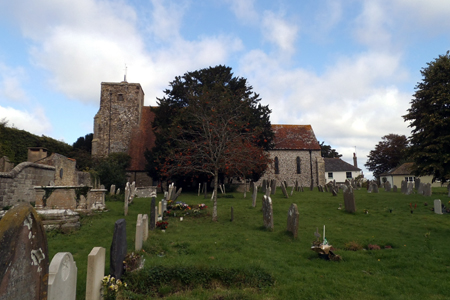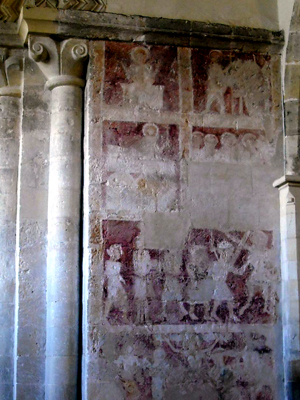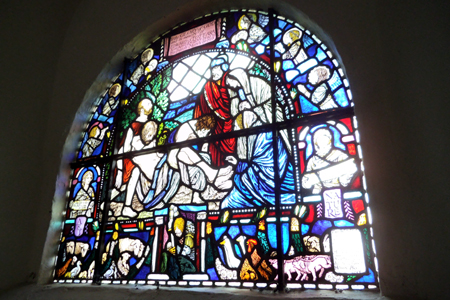| |
 |
 |
 |
| Comment on this report, or find other reports. |
 |
| Our Mystery Worshippers are volunteers who warm church pews for us around the world. If you'd like to become a Mystery Worshipper, start here. |
 |
| Find out how to reproduce this report in your church magazine or website. |
|
|
| 3080: St Michael & All Angels, Amberley, England |
 |
 |
 |
Mystery Worshipper: Teutonic Knight.
The church: St Michael & All Angels, Amberley, West Sussex, England.
Denomination: Church of England, Diocese of Chichester.
The building: This church is believed to have been built around 1100. The nave still has two painted consecration crosses, a rare survival in English churches. The chancel was extended in the 13th century. The tall chancel arch with its triple zigzag decoration is magnificent. Also in the 13th century the south aisle and tower were added. Unusually, the tower is taller than the walls of the adjacent castle and now houses a ring of six bells. There is only one post-medieval structural addition recorded before the Victorians set to work: a south porch in 1637, sadly replaced in the 19th century. There is historic graffiti on the pillars by the door, some obviously by repeat offenders carving multiple marks. The Victorian carved pulpit replaced an earlier two-tier one, but incorporated a late 16th century iron hourglass stand with the glass supported by winged cherubs. Sadly, it was stolen like almost all such sermon timers, but it survives in photographs. The stained glass in the north aisle depicts the entombment of Christ based on a painting by Edward Stott RA (1855-1918), who lived locally and in whose memory the glass was given. In spite of the Victorian zeal to whitewash everything, one of the 14th century wall paintings survives on the south chancel arch; the faded images can be identified as scenes from the Passion. The churchyard is large and contains several interesting monuments.
The church: St Michael's is one of four churches of the united benefice, which goes by the name of Wildbrooks and serves communities along the River Arun. While the harvest festival was celebrated the previous week in one of the other churches, there was no trace of it here. St Michael's ministry appears to be that of a typical village church serving the local community and school. They are holding various events in aid of the much needed tower restoration. There are film nights in the church hall and regular seasonal village lunches with a traditional Sunday roast. For the second year they are running a living Advent calendar in the village, with people opening their homes or gardens for some festive cheer to celebrate community life and faith. The parish magazine is as much about the church as it is about the village and local people.
The neighbourhood: Amberley is a charming village that lies above the water meadows of the River Arun with a number of thatched houses – the name reputedly means "a field of buttercups." Its "castle" is in fact a fortified manor built in 1380 as an episcopal summer residence for the bishops of Chichester. It is now a hotel favoured by celebrities as a fancy wedding and party venue. A little walk away is Amberley Museum & Heritage Centre, an open air industrial museum sited in 36 acres of land of the former lime kilns. It holds regular vintage events (cars, motorcycles, radios, etc) and has a collection of old busses, a narrow gauge railway, fire station, and electricity hall, as well as vintage workshops.
The cast: The Revd Alison Pattenden, vicar, attired in seasonal green, preceded by a crucifer and robed choir of six. There were no other servers. The parish magazine informs us that the vicar will be retiring at the end of October for reasons of health.
The date & time: Twentieth Sunday After Trinity, 10 October 2016, 11.00am.
What was the name of the service?
Sung Eucharist.
How full was the building?
It was a disappointingly low turnout of 13 plus choir on this fine autumn day. However, it is the only Anglican church I have ever attended where the men in the congregation significantly outnumbered the women.
Did anyone welcome you personally?
Yes. I walked down the narrow lane to the sound of the bells and met a couple on the church path. We exchanged greetings. Then I bumped into someone else in the porch. Inside, the vicar gave me a quizzical look, and came over for a few words once I had settled into my pew. A gentleman sitting behind me leaned over to retrieve a hymn book that he had apparently placed on the seat earlier. I was a bit put out that he didn't see fit to share the pew with me, or even say anything at all to me. I had obviously picked "his" pew, and sharing does not seem to be the done thing here.
Was your pew comfortable?
It was surprisingly comfortable, with a higher than usual straight back rest and a carpet pew runner. Since no other "bums on pews" apart from mine anchored it there, the whole length collapsed in a pile on top of me when I dropped to my knees for the prayers.
How would you describe the pre-service
atmosphere?
There was quiet talk by the few people who were present. The vicar mingled with her flock. The bell ringers all left before the service began; one of the ringers gave embarrassed apologies when he rushed out past my pew after his morning’s duty.
What were the exact opening words of the
service?
"Good morning in seasonal appropriate temperatures." The notices followed, and then the first hymn was announced.
What books did the congregation use during the
service?
An in-house order of service and the New English Hymnal (words edition – although the tunes didn't at all sound like NEH!). Pew Bibles were available, and I spotted both the New International Version and the Good News Bible.
What musical instruments were played?
Electronic organ, played by an organist attired in black gown with academic hood. A robed choir of adults with evenly balanced voices sang from the stalls, clustering around their leader during the anthem. The singing was surprisingly cheerful despite the low turn-out.
Did anything distract you?
My eyes were drawn to the faded mural on the right hand side of the chancel arch. I tried to work out the scenes.

Was the worship stiff-upper-lip, happy clappy, or
what?
This was a very low end of the catholic candle, with fully robed cast, and dignified entrance and recessional, but no gospel procession. The epistle was read from a large Bible by a gentleman who ascended the pulpit, while the gospel was proclaimed and the sermon delivered from the lectern. There was no Old Testament reading and no psalm other than a rather unorthodox use of one in the intercessions. Somewhat in contrast to this low-ish practice, we were explicitly invited to kneel for the eucharistic prayer; most people did. Although this was a late morning service with hymns and choir, it had more of an early morning quiet devotional about it.
Exactly how long was the sermon?
15 minutes.
On a scale of 1-10, how good was the preacher?
8 – The vicar spoke from the lectern rather than the pulpit. She did not appear to use notes, avoided pontificating, and had a pleasantly deep voice. It was a thoughtful take on the theme of gratitude, and though it was relatively long there was a slight change of emphasis somewhere around the mid-point, where it switched from the gospel (Luke 17:11-18 – Jesus heals ten lepers) to an exposition of the epistle reading (2 Timothy 2:8-15 – do not quarrel over the truth of God's word), so that drifting minds were brought back on track.
In a nutshell, what was the sermon
about?
Ingratitude is nothing new, and gratitude is a positive mindset that needs to be cultivated. The old saying: "Sticks and stones may break my bones but words can never hurt me" is rubbish! The power of words should never be underestimated. God spoke, and the world came into being. Jesus healed by words more than actions. Words can destroy as well as make people. The lepers in the gospel expected alms. Instead, a command from Jesus healed all ten of them, and a word from the priest will then readmit them into society, ending both physical ailment as well as social isolation. Paul reminds Timothy that God remains always faithful even though we turn away. God does not expect thanks but keeps on giving. However, this does not mean that none should be given. Likewise, we ourselves should not expect thanks for our own generosity to others. We need to be thankful for the little as well as the big mercies. Gratitude brings us closer to God and each other, while lack of it drives us apart. The act of worship is an act of thanksgiving for the saving work of Jesus.
Which part of the service was like being in
heaven?
The vicar summed up the theme of gratitude in her sermon by thanking the congregation for listening. Intercessions were unusual in that they were mostly a reflective round of thanks rather than pleas for more and better whilst not neglecting those in need. The intercessions finished with the 139th psalm (you know me, Lord). We were invited to think of what each verse meant to us. It was read slowly enough to make such reflection possible, while not so slow as to become tedious or magisterial.

And which part was like being in... er... the other place?
The custom here seems to be to sing the hymns like Anglican chant with a pause before the first note of each verse. I could not get used to this.
What happened when you hung around after the service looking lost?
I'm afraid I did not hang about since we were set to catch the best of the weather for a leisurely stroll along the riverbank, and it was already clouding over as the darkening of the east window indicated.
How would you describe the after-service
coffee?
There was no coffee – which, given the low turnout, was not surprising, but we sampled the local tea shop after our walk, a charming little place in the old bake house that serves teas in locally-made pottery.
How would you feel about making this church your regular (where 10 = ecstatic, 0 = terminal)?
8 – I loved the quiet devotion of this place during a late morning sung eucharist. I only wish there were more people.
Did the service make you feel glad to be a
Christian?
Readings, sermon and intercessions on a theme of gratitude could do no other than leave you profoundly grateful.

What one thing will you remember about all this in seven days' time?
Kneeling for the eucharistic prayer in an Anglican service that was not higher than Rome. |
|
|
 |
 |
 |
| We rely on voluntary donations to stay online. If you're a regular visitor to Ship of Fools, please consider supporting us. |
 |
 |
 |
| The Mystery Pilgrim |
 |
| One of our most seasoned reporters makes the Camino pilgrimage to Santiago de Compostela in Spain. Read here. |
 |
 |
 |
| London churches |
 |
| Read reports from 70 London churches, visited by a small army of Mystery Worshippers on one single Sunday. Read here. |
| |
|
|
|
|


